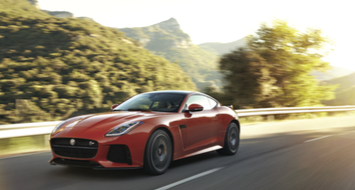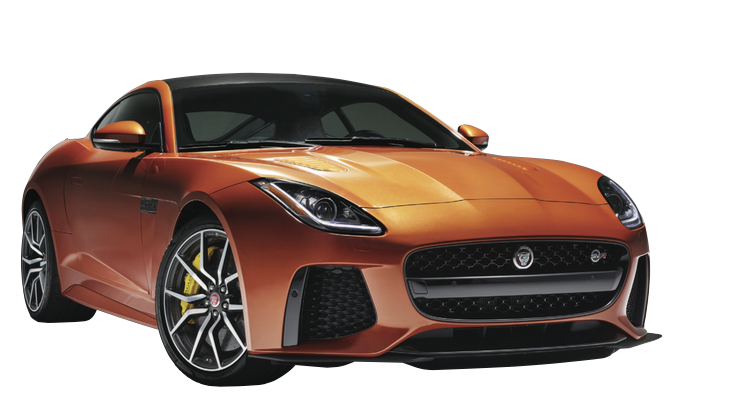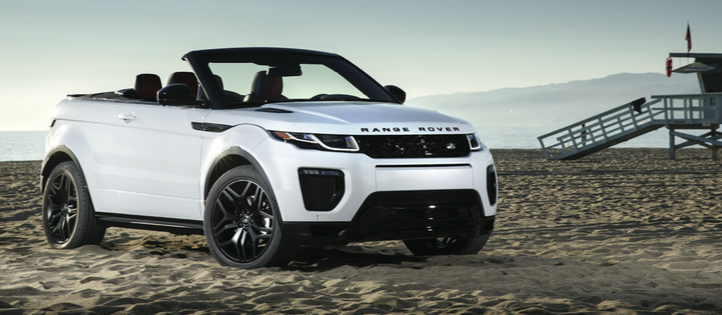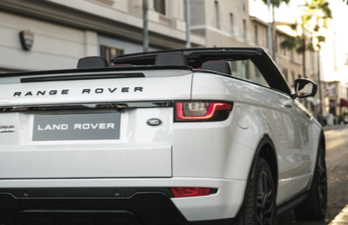A Look At The Jaguar F-Type SVR And Range Rover Evoque Convertible
Jaguar and Land Rover are storied brands, both growing up in the English countryside and wending their ways through history via very different paths—Jaguar manufacturing both sporty and elegant cars, and Land Rover creating some of the sturdiest off-road vehicles known to man (and the Queen). And who could have foreseen, during each of their many decades of independence, that one day they would be joined (corporately speaking) under a single owner… and that the owner bringing them together would be India’s Tata Motors?
But that’s what happened in 2008, after each of the brands tried different corporate betrothals (most recently, Jaguar was part of Ford and Land Rover was part of BMW until Ford bought Land Rover, too, in 2000). Presumably, each company can leverage the engineering achievements of the other, producing even better cars than before.

That said, let’s start with the fast cat: the Jaguar F-Type SVR. It has a ton of power (try 575 on for size), a top speed in excess of 200 miles per hour, and acceleration that can easily get you arrested in virtually every corner of the planet. Who needs that kind of power, you ask? If that’s your thought process, this isn’t for you. But mea culpa, this coupe—this fire-breathing, exhaust-crackling, road-hugging, scofflaw- encouraging coupe—is lovable.
Early on, Jaguars were among the leading cars of the world. Starting with its race cars in the 1930s, Jaguar was highly sought after by royalty (both real and entertainment) and its cars won races globally. Even Enzo Ferrari himself—certainly a man who knew automotive beauty when he saw it—was quoted as saying that the Jaguar XK-E was the most beautiful car ever made.
The F-Type burst onto the U.S. motoring scene in 2013 and, smartly, it was offered with a wide array of options, including motors with a big spread of power choices. It first came in convertible and, soon thereafter, coupe. Then, both were introduced with ‘R’ variants and more horsepower—500 and 550, respectively. But now Jaguar’s top performance moniker, SVR, has upped both of their power levels and top speeds. While you may have thought the F-Types were as good as it gets, the SVR moves the bar even higher.
Aside from its stunning good looks and impressive performance, this car is luxurious. A killer sound system adds to the pleasure, if you can stand to interfere with the arias being created by the power plant. And it even comes in a convertible (about $3,000 more), for those who like the wind in their hair at 25 percent of Mach 1. The convertible has a great feature that all manufacturers should adopt: the driver can punch in a code on the infotainment screen, which both locks the glove box and also turns off the sound system. Not since Corvette offered an in-car video monitoring system has a manufacturer better thwarted the efforts of Ferris Bueller’s nemeses.
For a car with a base price starting at about $61,000 for the least expensive coupe, the SVR is a big jump—tipping the scales with a base price of about $126,000. Is it worth it? Get in, fire it up, and then decide. If Nyou’re a petrolholic like some of us, just the sound upon its awakening will be worth the price of admission.
Now let’s look at its off-road cousin, Land Rover. The company has broadened its output recently so that numerous vehicles it creates are being sold in the U.S.—the Discovery Sport is the least-expensive model, starting at about $38,000. Moving upward in the line, we find the Land Rover Discovery, Range Rover Evoque, Range Rover Sport and Range Rover, which also has many variants—the SVAutobiography and the ultimate Holland and Holland, a very customized version of the Range Rover Black, which includes Holland and Holland, the ultimate Range Rover Black with gorgeous leathers and tooled metalwork reminiscent of the finest shooting guns ever made (and starting at about $225,000). But back to today’s topic: the Range Rover Evoque Convertible, a bundle of joy with a base price of $52,000.
Although you may have seen the Evoque before, as it hit the road a few years ago, this year’s convertible model simply adds to the already-youthful vibe with a roof that drops noticeably from front to back. This swagger for the normally sedate (and much more rectangular) Land Rover family gave the Evoque a street strut that endeared it in the hearts of youngsters and the young at heart. With two basic models—the SE and the HSE (the latter has a base price of $57,700)—all convertibles have the same four- cylinder powerplant with 240 horsepower and 250 pounds of torque coupled to a nine-speed automatic and all-wheel drive.
There’s one metric, especially in Los Angeles, by which the Range Rover Evoque Convertible is hard to beat: stares per mile. Whether in Beverly Hills or Newport Beach, the drop top is a real head-turner. One valet literally moved a Rolls-Royce (one of three parked in front of the restaurant) to give the convertible center stage. When we returned to the stand after dinner, he said that he’d never seen so much interest in a car—and he regularly hosts the most exotic of models from anywhere in the world.
And while the Evoque Convertible is a fun, well-priced car, it’s also very technologically advanced. It uses a sophisticated power-and-brake management system called “Torque Vectoring by Braking,” which is especially useful off-road. There are also driver-control programs for low-friction surfaces, venturing up and down hills, and more. The infotainment system with 10-inch touchscreen is great, and the Meridian sound system works terrifically—ten speakers plus a subwoofer.
With the four-banger engine, you will not win many Stop Light Grand Prix, but its performance is sprightly. Overall, the Evoque Convertible is a lot of fun to drive. You probably won’t want to return this baby after taking it for a test drive. Because, even if your typical daily diet includes at least 500HP, the Evoque Convertible is a surprising delight.















